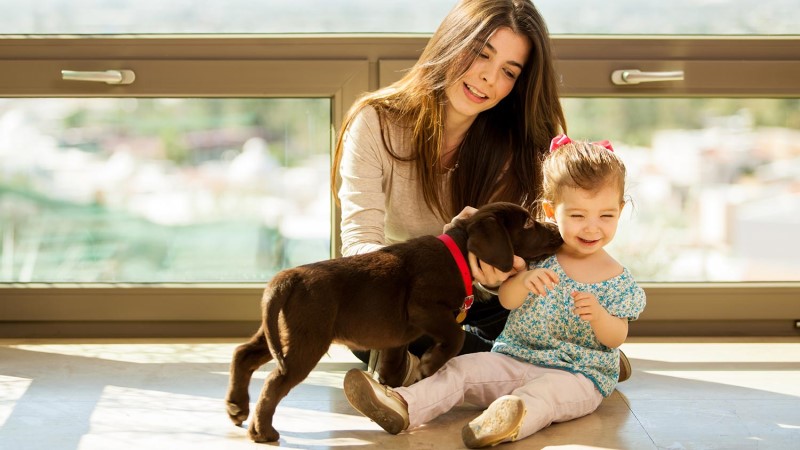Although there is some truth to the statement “too many cooks in the kitchen,” it doesn’t always apply to dog training! Families – households with more than one human – can successfully train their dogs together and help their dogs maintain those desired behaviors. Here are a few ways to ensure everyone in your family is creating a positive training experience for your dog!
Create a Cue Sheet
A cue sheet lists all the skills and corresponding verbal and body language cues that request a behavior from the family dog. For example, the word “sit” with the gesture of the right hand moving toward the bicep is used to request that a dog place their backside on the ground. This cue sheet will help family members be consistent with the dog. When your dog receives consistent information, they will learn faster!
Have Everyone Learn the Concepts
All family members should attend training classes, read the class handouts, read books about dog training, and so on. If any family members are unable to attend training classes due to limitations on the number of human attendees or busy schedules, the attendees should schedule time with the non-attendees each week to demonstrate what was learned. Attendees should pretend to be the dog training class instructor – demonstrating skills, offering positive feedback, and assisting the non-attendees with the skills.
One important concept is properly handling and touching the dog. All family members should learn to gently and respectfully handle and interact with your dog. In addition, adult family members should supervise the kid’s interactions and training sessions.
Take Turns Working with the Dog
Your dog notices who supplies all the good resources, such as walks, hikes, food, treats, playtime, and snuggling. Naturally, your dog will bond the most with the family members who spend the most time with them! To help ensure everyone has a special connection and that the dog learns to work with and listen to all family members, have everyone take part in their care. Vary who exercises, trains, feeds, gives water to, plays with, and cuddles your pup!
Keep Track of Everything
If all family members are participating in the dog’s care, it could be easy to get confused about how far the dog walked today or how much they ate. Track this information, along with the family member who performed the care item, in a notebook or on a wall calendar. Not only will this help you see trends over time of who is doing what and how often, it will also help prevent a skipped or double meal. You can even order a personalized notebook or calendar that displays a favorite photo of your dog!
Use One Handler at a Time
Have you ever had two managers ask you to do two different, conflicting things? Not only is that confusing, but it’s also very stressful. Imagine being a dog – one of your humans is asking you to perform tricks and the other human has the leash and all the treats! Who should you look at? Perhaps you should pay more attention to the body gestures of the human who has all the treats.
To help your dog and family succeed, have one family member at a time be the “trainer.” The trainer has all the tools and performs all the actions with the dog. The trainer has the leash, clicker, and treats in a pouch. The trainer holds the dog’s leash, says the cue word, gives the hand gesture, tells the dog he was correct, reinforces the dog with a treat, and releases the dog from the skill (“ok”). The other family members may watch – often from a seated position a few feet away – and offer positive, helpful comments to the trainer.
Be careful not to have another family member hold the rest of the treats – this will tempt the dog to think that that person is the trainer. After the trainer has mastered the basic steps and sequencing of a skill, the trainer may pass all the tools and the leash off to another family member for their turn to be the trainer. Read this blog for more tips on how to be a successful communicator to the dog during training.
How Can Kids Help Train Your Dog?
The above tips will need to be modified for families with small children or children who cannot control the dog without an adult’s help. In these instances, the children may need to be the second trainer who works the dog after the other trainers in the family have reached fluency with the dog – meaning the dog understands and performs the skill in a variety of settings and distractions – and possibly when the dog can be off-leash in the safety of the home.
If a leash is needed, parents can always hook up two leashes to a dog’s collar or harness – one can be held by the child and one can be held by the parent as a back-up. This two-leash method may work best in an indoor, at-home session to prevent the dog from dashing off to another room to explore.
With parental supervision, children may also be good at changing water bowls, measuring food, putting down food bowls, filling out the care notebook or calendar, and giving the dog a “good night cookie” treat at the end of the day with a flat hand.
For more resources, check out AKC’s Family Dog Program.
Take some of the stress out of the unexpected with Accident & Illness Coverage from AKC Pet Insurance (underwritten by Independence American Insurance Company). Our dog pet insurance plans are designed to be there when you need them, allowing you to focus more on the health of your pet and less on costly veterinary bills. Click here for a quote today!
,

